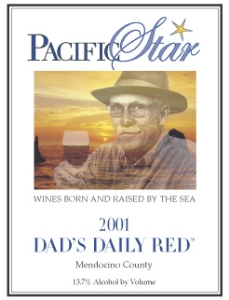 |
|
Wine Details
Price:
$12.00 per bottle
Description:
Sally's tribute to her Dad, Fred, who's a healthy 82 and always ready to help out at the winery. It's become everyone's favorite blend - old vine Carignane, Grenache, Zinfandel, Merlot, Petite Sirah and the rare Charbono. Don't let the moderate price fool you, it ages beautifully for many years but we suggest you drink it now and lift a glass to Dads everywhere! The backbone of our 2001 Dad's is the Rhone Valley's principle commodity grape, Carignane, grown plentifully in Mendocino County. We carefully blend in Zinfandel, Grenache, Petite Sirah, Merlot, and the rare Charbono. Spicy with medium body and moderate alcohol content, Dad's resembles the table wines of the Tuscan ancestors of our Mendocino County grape growers. Hearty Italian style food is a perfect match and Dad's goes down easy in the warm evenings of summer. There's more to the story.
|
|
|